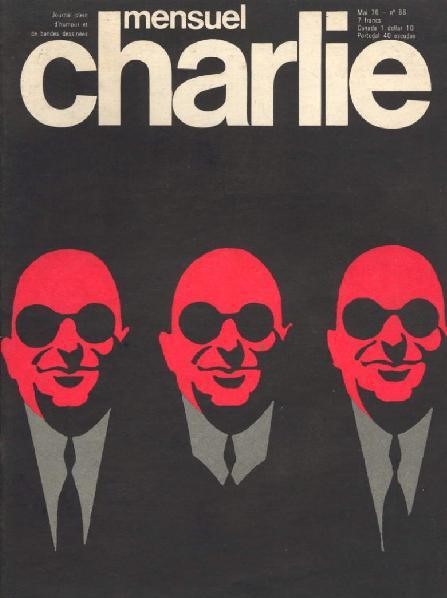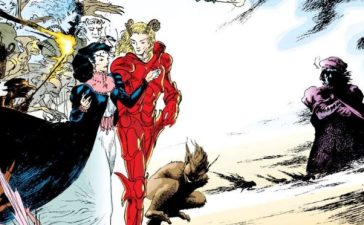
“A Terrible Day For All Cartoonists” – A Cartoon Response to Terrorism
One of the most poignant images created in reaction to last week’s terrorist attack on the headquarters of the French satirical magazine Charlie Hebdo that killed 12 people, including five cartoonists, was a cartoon depicting the iconic comics character Charlie Brown sitting on a bench, apparently crying. The image was created years ago by Charlie Brown’s creator, Charles Schulz; after hearing about the attack, British writer and editor Magnus Shaw added the words “Je Suis Charlie” (“I am Charlie”) to the art, and tweeted the cartoon with the following message – “A terrible day for all cartoonists. #JeSuisCharlie”.
The image was re-tweeted and favorited by thousands, and featured on multiple news sites (including Reuters, USA Today, BuzzFeed, and The Independent) as an example of the cartoons created in response to the tragedy. Shaw’s use of the Charlie Brown cartoon was particularly apt, as the character indirectly inspired the name of the magazine.
A terrible day for all cartoonists. #JeSuisCharlie pic.twitter.com/Ksbl89WLsE
— Magnus Shaw (@TheMagnusShaw) January 7, 2015
As reported by The Guardian, Charlie Hebdo (“Charlie Weekly”) takes its name from both French statesman Charles de Gaulle and the monthly comics magazine Charlie Mensuel (“Charlie Monthly’); when the French satirical magazine Hara-Kiri was banned by authorities for mocking the news coverage of de Gaulle’s death in 1970, the editors changed the name of the magazine to Charlie Hebdo “because there was a monthly comic book in existence called Charlie Mensuel (named in turn after Charlie Brown) and as an irreverent reference to the recently deceased father of the French Fifth Republic.”

In their book Comics: A Global History, 1968 to the Present, comics scholars Dan Mazur and Alexander Danner note the influence of Charlie Mensuel on French comics: “Edited by Hari-Kiri cartoonist Georges Wolinski, Charlie‘s pages mixed Peanuts, Dick Tracy, Andy Capp and other English-language newspaper strips with the Hari-Kiri lineup of Gébé, Reiser and Copi, who worked in cartoony, calligraphic styles and held nothing back from their ‘sick’ humor and social satire. With its mix of classic and contemporary international comics as well as original French work, Charlie was the first French journal to present comics in the context of an adult sensibility.”
Charlie Mensuel ceased publication in 1986, and its editor Georges Wolinski served as editor of Charlie Hebdo between 1970 and 1981. Wolinski was killed during the attack on the Charlie Hebdo headquarters.

Although Charlie Hebdo has a connection to the Charlie Brown character that adds a level of poignancy to the Schulz cartoon tweeted by Shaw, no knowledge of this connection is necessary to appreciate the powerful image. Nothing But Comics! contacted Shaw (a writer and the editor of the weekly online music and pop culture magazine The Rocking Vicar) by email to ask him about the cartoon.
NBC!: Where were you when you heard the news about the attack on the offices of Charlie Hebdo?
Shaw: I was writing at my desk and it was announced on the radio.
NBC!: Your “Je Suis Charlie” cartoon has been re-tweeted and favorited by thousands, and featured on many internet sites. The cartoon uses an image of a saddened Charlie Brown (an original illustration by creator Charles Schulz), with the words “Je Suis Charlie” added by you above the character. Could you tell us the story of how you selected that particular Schulz image?
Shaw: I wanted to express my dismay at what had happened in a creative way, and was actually just going to use the zig-zag pattern from Charlie’s sweater, but while browsing for a reference image, I came across the picture of Charlie crying and knew that was a far better, far more poignant picture. A minute in Photoshop and it was done.
NBC!: When you created the cartoon, were you aware of the connection between the magazine Charlie Hebdo and the French comics magazine Charlie Mensuel, which was inspired by the Peanuts comic strip?
Shaw: I had no idea – unless it was a subconscious memory. For some reason I just linked the name “Charlie” to Charlie Brown. It was only later that somebody pointed out the more definite link to me, on Twitter. I was quite surprised, but appreciated it made my image all the more powerful.
NBC!: You have written articles about advertising and music, and have had your work accepted by the British comics magazine Viz. Are you a comics fan? Do you have any favorite comic books, graphic novels, comic strips or webcomics that you enjoy reading?
Shaw: Well, my contribution to Viz (which I wrote with a former colleague) was very small indeed, but it lives on in their book! Yes, I’ve loved comics all my life. I’m pretty obsessive about all things Batman, and adore the Hellblazer and Swamp Thing graphic novels. Alan Moore is probably the master of the art. Watchmen remains a high watermark for comic books, I think.
NBC!: You regularly write articles, but do you have any desire to create more cartoons or comics?
Shaw: I have no intentions of launching a cartooning career, no. Funnily enough, I’m pretty rotten with a pencil. But I’ve worked in advertising as a copywriter for many years, and seem to have the knack of marrying the right words to the right image. I’m genuinely delighted by the response to the Charlie Brown image, so you never know!
The images above are the property of their respective owner(s), and are presented for not-for-profit, educational purposes only under the fair use doctrine of the copyright laws of the United States of America.








